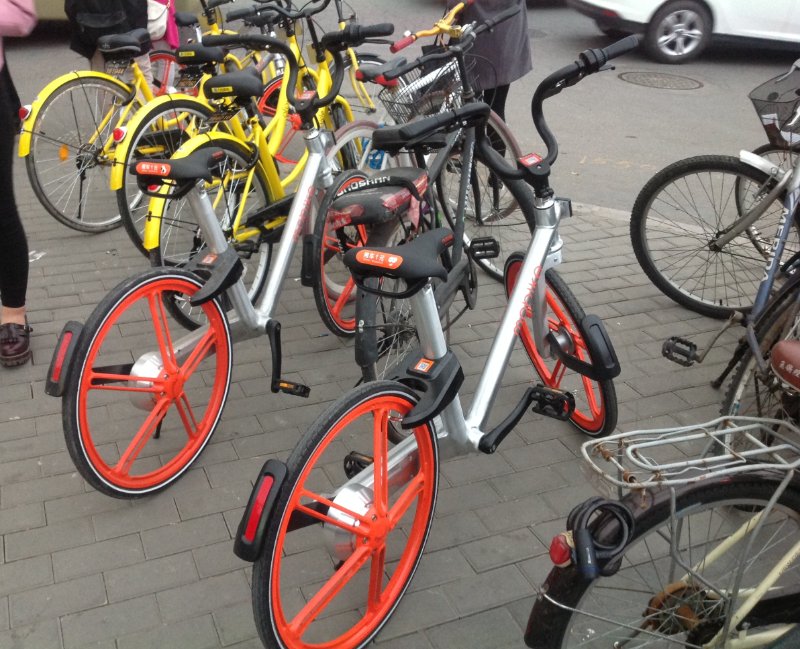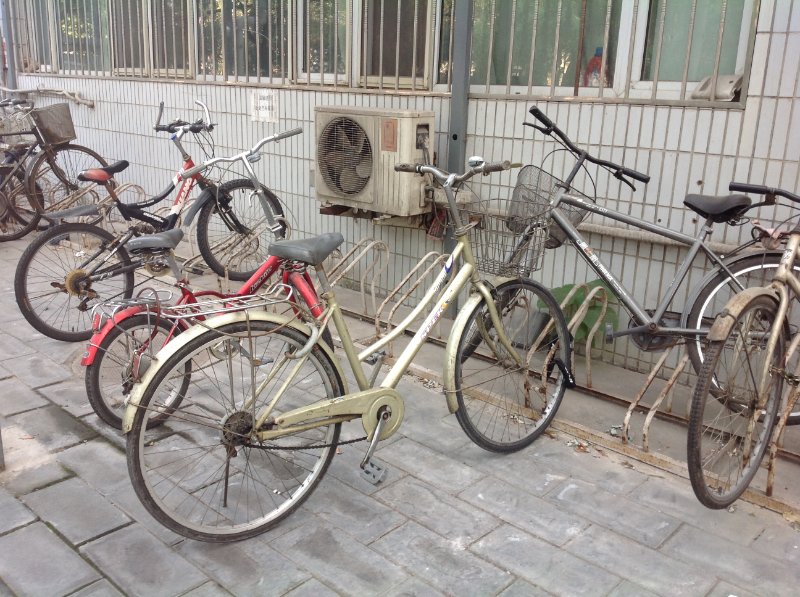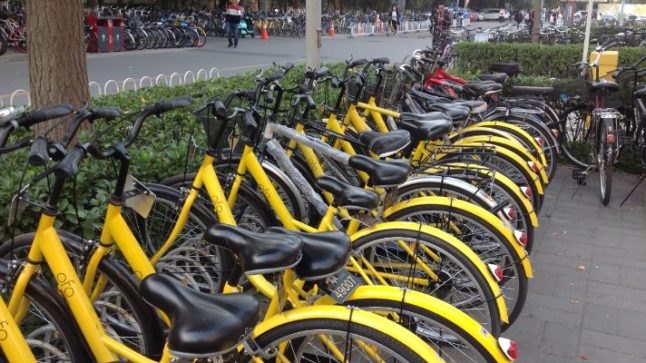When bike-sharing first emerged, it was proclaimed to be the newest frontier of China’s sharing economy. And following the big fight between Uber China and Didi, it was quickly compared to ride-sharing. But there’s a problem.
- Bike-sharing is not really sharing. It is not part of the sharing economy.
- Bike-sharing does not have a network effect (yet).
- Bike-sharing has no real economies of scale (yet).
- There are some questions lingering about long-term consumer demand, especially outside of China.
Basically, bike-sharing is nothing like Didi, Grab, Ola, Uber, AirBnb and the others. Its economics are far more like an on-demand rental business or a vending machine business at this point. Although it is evolving steadily.
That doesn’t mean it isn’t a really great, scalable business. It is. It has done spectacularly well in China and I hope it has explosive growth internationally. I really like seeing Ofo’s bright yellow bikes all over Peking University.
But much of the current excitement seems to be because people think this business is like Didi. It’s just not. It’s a different thing.
Here are four ways bike-sharing is different than ride-sharing.
1. Bicycle-sharing does not have a network effect.
Ride-sharing (i.e,. using cars) is awesome because it has a powerful competitive advantage via a two-sided network. Basically, each additional rider increases the networks’ value to the drivers (i.e, more customers and they are closer by.). And each new driver increases the value of the service to each rider (i.e., shorter wait times, more cars available). So platforms with larger volumes actually have a superior service offering to both populations. And in two-sided networks, the market usually collapses to the leading companies quickly (Uber and Lyft in the USA, Didi in China, Ola in India, Grab in SE Asia, etc.).
Additionally, once the market has become consolidated in 1-2 companies, it becomes very difficult for a new entrant to break in. If you then want to launch a ride-sharing service, you will have to offer the same large driver network and short wait times as the dominant competitors from day one. But to get all those drivers, you have to offer them a big customer base. It’s a “chicken-and-egg” problem but with already entrenched competitors. It is really difficult to break in. We can see this type of indirect two-sided network effect in home sharing (AirBnb), credit cards (Visa, MasterCard), app stores (Apple, Google Play), auction houses (Sotheby’s, Christie’s), and even shopping malls (sort of).
But none of this happens in bicycle-sharing. There is no second population of drivers using the platform – and providing the cars (which are the key assets). You just need to put lots of bicycles around town. Each new rider does not add any value to the other riders, nor to a second population of users (such as drivers).
Bike sharing is mostly a traditional, vertically integrated b2c rental service. It is a very innovative traditional merchant business. Being bigger helps somewhat but it is still possible for a well-run, well-funded new entrant to enter. This will probably limit long-term profitability.
However, in the short-term companies like Ofo and Mobike should do really well. They are offering an innovative new service and are first-movers in a wide-open and massive market. The near-term growth story is awesome. The longer-term profitability and return on capital is not yet clear.
 Ofo and Mobikes outside a Beijing subway
Ofo and Mobikes outside a Beijing subway
 Note: Older bikes are still everywhere in China – and dirt cheap (around 100-200 RMB used)
Note: Older bikes are still everywhere in China – and dirt cheap (around 100-200 RMB used)
2. Bicycle sharing doesn’t have economies of scale (yet).
Another question is about the fixed costs and fixed assets, which can be another type of barrier to competition. If you have large fixed costs, a larger competitor can often provide a service cheaper on a per unit basis. Also, a big initial and / or ongoing capex requirement can deter entrants, such as in the constantly upgrading cable and telecommunications companies.
But the fixed costs and fixed assets haven’t been a huge advantage in bike-sharing yet. Yes, you have to provide a certain number of bikes to have the same convenience as the big, established players. And yes, there are going to be data and other intangible assets that will be very important. But the costs of placing and maintaining bicycles around the city isn’t that big. It’s not like going up again China Mobile where you would have to replicate a nationwide telecommunications.
3. Bike-sharing is not really sharing.
Ride-sharing is about gathering a population of drivers, who then provide and maintain their own cars. In AirBnb, people provide their homes. It’s basically about using new digital technology to bring existing but unused supply into the market. It’s a big deal.
For this type of platform, you don’t have to own the assets or spend the capex to grow and maintain them. You can be the world’s biggest car rental company without owning any cars. For the owners of these assets, they benefit from renting them out and dropping their effective cost. And for customers, they can cheaply utilize other people’s assets – and theoretically avoid buying their own (in some cases).
But there isn’t really any sharing happening in bike-sharing. Regardless of rider volume, the company must still buy and own all the bikes. And it must maintain them and replace them (say when they go missing). No assets are being shared.
4. There are some interesting questions regarding consumer demand, especially internationally.
In the past +15 years, bike-sharing services have been launched in over 600 cities around the world. Most were local government initiatives. Some have been pretty successful. Many have failed, usually due to a lack of demand or bad management. Or maybe people just didn’t want to ride bicycles.
The demand for on-demand bicycle trips “under three kilometers” was not totally clear. In China, that question has now been answered. It is very popular. People love riding the bike and use them all the time. It turns out the demand was always there. Owning bikes was just too inconvenient.
However, the demand outside of China and long-term is less clear. In China, we see lots of trips to the metro and on campuses. And when you place bicycles within arms’ reach of people at a negligible cost (1 RMB in China), people start using them without thinking – and in lots of new ways.
One place we can see lots of cool new usage is with Ofo at Peking University. Those yellow bikes are literally everywhere. Another example are the bikes sitting outside of the subways. You get off the subway, pay 1 RMB, peddle the five blocks to your house and just drop the bike. That’s pretty great. I think there are going to lots of surprises in how people start to use these bikes in China.
However, my biggest concern for the customer proposition of bike-sharing is that it doesn’t save you money. Home-sharing and car ride-sharing are convenient, like as-needed bicycles. But they can also be much cheaper than hotels (and sometimes taxis). This kind of big cost saving doesn’t happen with bike-sharing. It’s mostly about the convenience.
There are also lots of cheap ways to get around town in China. By metro, by taxi, by walking, by mototaxis, by scooters and by owning bicycles, many of which also cost next to nothing. And China is already over-run with bicycles, including mountain bikes, street bikes, fold-up bicycles, e-bikes and electric scooters. Note: new bicycles start at about 399 RMB at reputable stores.
 Scooters, e-bikes and cheap hire trikes (for hire) are everywhere.
Scooters, e-bikes and cheap hire trikes (for hire) are everywhere.
 The newer e-bikes are pretty common and start at 1,500 RMB. Note the gloves and blanket for weather.
The newer e-bikes are pretty common and start at 1,500 RMB. Note the gloves and blanket for weather.
So the consumer proposition for bike-sharing is mostly convenience plus negligible cost – not saving money.
And outside of China there are lots of questions about demand. Will these be popular in Mexico City? What about hilly cities? Also keep in mind, riding a bicycle has some other issues. Like the weather, riding at night (no lights on these bikes), the requirement to peddle, and so on.
A final point: This is a really nice service. But I would marry a BAT ASAP.
Most of what I just said you could also say about the iTunes store. Or about the super-popular beauty photo app Meitu. They are highly innovative B2C services that operate as traditional merchants, not as multi-sided platforms. And these services also did really well in the short-term by being first movers with a lot of adoption.
But they eventually need to partner up with other services that have clearer business models and stronger competitive advantages (the iTunes store is mostly a merchant but the App Store is an MSP). And as Baidu, Alibaba and Tencent are +50% of all mobile internet usage in China, that’s the target. Basically, bike-sharing should join Team Didi or Team Tencent ASAP and integrate their cool new service into a bigger ecosystem. That would be game over.
***
Overall, bike-sharing seems a really cool new service. And they raise a neat question about what will people do with on-demand bicycles that are always within arms-reach at a negligible price? It is going to be fun to watch this play out in China’s increasingly crowded cities.
Cheers from Beijing, Jeff
—–
I am a consultant and keynote speaker on how to accelerate growth with improving customer experiences (CX) and digital moats.
I am a partner at TechMoat Consulting, a consulting firm specialized in how to increase growth with improved customer experiences (CX), personalization and other types of customer value. Get in touch here.
I am also author of the Moats and Marathons book series, a framework for building and measuring competitive advantages in digital businesses.
Note: This content (articles, podcasts, website info) is not investment advice. The information and opinions from me and any guests may be incorrect. The numbers and information may be wrong. The views expressed may no longer be relevant or accurate. Investing is risky. Do your own research.
Photos by Jeff
